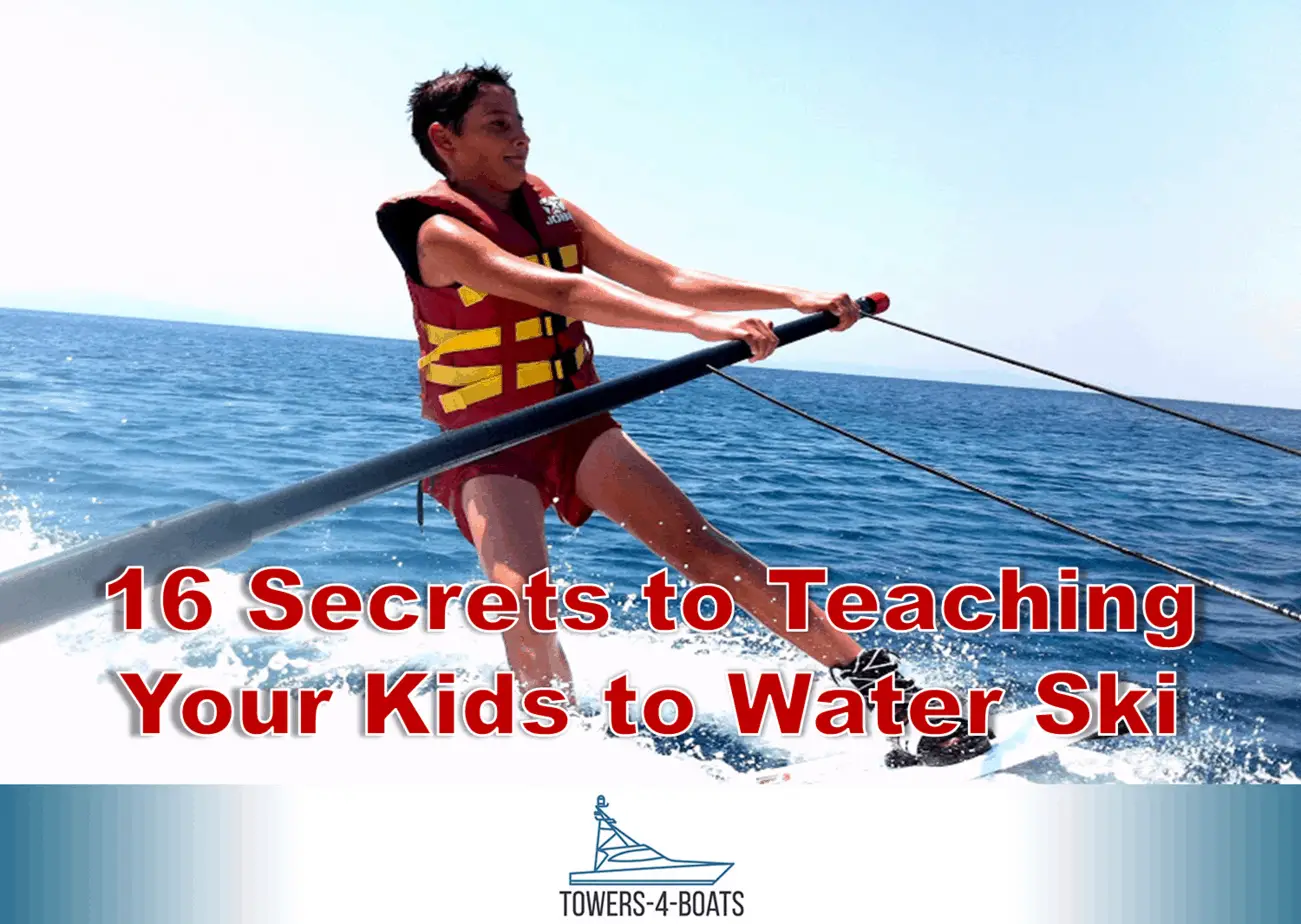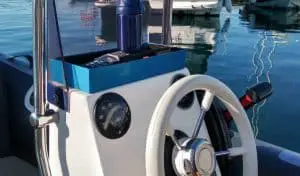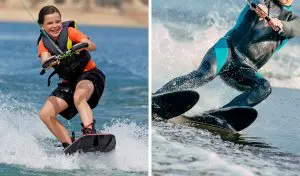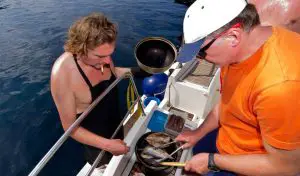How to Teach Your Children to Water Ski
All my life, I’ve been around boats. I come from a long line of lake-loving water skiers, both slalom and barefoot skiers being my kin. But I’ve got a confession… that I can’t water ski.
And I don’t have to look back and wonder why I’ve never taken a kid to the sport, I know the exact moment! Not only was I unable to keep myself up on one of my first attempts, however, determined to make my parents proud, but I also held tight to the rope, pulling myself under the waves. Needless to say, I swallowed a few tears of water and screamed, and I didn’t want to go water skiing again.
I still have zero ambition as an adult. But seeing younger cousins stand with limited effort in their first few classes, I sometimes wonder what might have been done differently to make my experience more productive. Here are my ideas.
My Secrets for Teaching Kids Water Skiing
1 Start by having fun in the water
Let them first become acquainted with the water before you even introduce the concept of water skiing to youngsters. Make sure they understand how to hold their breath and stay calm underwater. Give them space to splash and jump in.
You can also check out our 15 favorite ideas to make boating more enjoyable for children, in order to make your boat a fun, relaxed place for them.
Water skiing requires tapping into a different range of motor skills and it’s all its own juggling act. So then introduce them to a towable tube float after they’re relaxed with water. Let the children tell you how easy it is to pull.
2 Lead by Example
The best way to learn is by seeing others turn up first. As an adult who enjoys water, I believe you’ve ever skied in the water in front of your children before. But this time, explain what you do and why to them.
A little competition with a sibling can go a long way. Enable the older ones to show the younger ones how it’s done if you have several kids. Sometimes, seeing an older sibling or cousin will inspire children to try skiing as well.
It’s also worth noting that the inexperienced skier doesn’t want too many eyes on you. Only let it be your immediate family and don’t invite your neighbors on this first boat trip. When they don’t get it right in front of a wider audience, it puts a lot of pressure on children and embarrasses them.
3 Proper technique is crucial
Give some demonstrations of the correct body positions, ideally when in the water with an adult. Teach them how they can lean on their skis.
The easiest way for children to retain hand signals is for the captain to make them be a down spotter. If a thumbs up is given by the demonstrating skier, let your child warn the driver. They can sometimes forget and say “mom gave up a thumb.” Just remind them what “drive faster” means.
4 Ski on dry land first
Train with an adult on shore using their power to move the kid on skis across the ground. Teach them how to bend their knees and stick out their arms.
5 Find quiet, calm water for their first lesson
Having fast boats speeding through an area where you may need to let go of the rope is frightening. Choose a time when most boats are not out on the water yet, even if you have to offer your lessons in the morning or evening.
Find a peaceful spot where not a lot of boats are zipping by. For your beginner skiers, this decreases the number of waves and keeps them focused on the lesson rather than the proximity of moving ships.
6 Use positive words and constructive criticism
Keep patient and be optimistic no matter what you do! If a child has a hard time remembering to keep their skis together or keep bending their elbows rather than holding their arms straight, remind them why it’s wrong and show them the right way.
Kids are happy to please you, but they will never want to ski again if you get snappy or irritable! Encouragement and making it an enjoyable activity would have every child begging by the end of the season to go skiing!
7 A long ski rope makes learning easier
Don’t bind the boat to a rope. Keep an adult behind to hold it instead, so you can drop the rope if the skier falls. In retrospect, in my case, this may have helped. There are several explanations why children hang on a rope, and one is fear of the boat leaving them stranded.
When using an inflatable tube, the same goes. More than likely, a kid would be tossed and have no excuse to hang on, but bypassing boaters, a big float can be seen, making them feel safer in open waters.
Enable ample space between the engine of the boat and the boy. A common misconception is that the more taut and safe the kid would feel, the less rope. But closer to the engine, there are rougher swells as well. Start back with more than enough distance and let the rope out in increments of five feet, preventing prop-wash and keeping them where the water is smoother.
8 Talk to them continuously
Be sure to keep a conversation going when the rope is shorter. It puts children at ease and reassures them. Even, when they are ready for more rope, let them tell you. They’ll be so far away eventually that you might have to shout or use hand signals.
9 Remember they’re children – don’t push too hard
It gets tiring to bring up your body weight over and over again. On their very first time out, try not to exhaust them. Take a break or even call it a day if they look like they are slipping more often, or like they are just plain irritated. Make sure they take a snack and hydrate before they come in.
10 Celebrate the little achievements
Last but not least, make sure they know that they have done a fantastic job! Applaud them, even if they didn’t get up, for their efforts, and let them know that tomorrow is still there.
Ask your kid if he wants a picture to remember the day. I say “ask them” because they may want to take the picture on the day they do if they don’t feel proud of not getting up.
And on another note, on their first experience, do not take pictures of them in the sea. It’s yet another extra burden or humiliation, equivalent to your friends watching your family.
Tools to Make Learning Water Skiing Easier
11 Use a platform trainer
For teaching young people how to ski, EZ SKI trainers are amazing new floats. For some good reasons, they have rave reviews.
- They are wooden integrated ski trainers set inside an inflatable water toy with a seat on which children can rest until they are ready to stand. The float has a built-in handle, instead of having a ski rope that is attached to the boat and carried by the boy.
- They come in two sizes: EZ SKI 100 for kids up to 70 lbs and up to 120 lbs for teenagers and young adults. The manufacturer proposes to go at a speed of 10 mph, but reviews have suggested that it can be pulled at around 15 mph higher.
I wish they had been invented when I was young. They’d come in handy.
12 Buy a set of trainer skis
When a child is absolutely relaxed standing on a platform trainer, they will graduate to ski trainer.
Trainer skis are equal to the weight of a child and have a crossbar that holds the legs together as you ski. Then you can delete the crossbar if your kid has strengthened their balance.
Much like shoes, kids easily grow out of skis. But there are a few brands that can develop into a few junior water skis for your boy. Gladiator, O’Brien Jr. and Connelly. For beginner skiers, Vortex Kids Combo Water Skis are nice choices. For rising feet, get a pair of adjustable bindings.
13 Add a boom to your boat
For children with shaky knees who are still learning positions, a boom provides extra stability. It also helps to coach next to the boat without having to yell over space and a motor, where the adult teacher can.
14 Use floating ski rope
Make sure that floating water ski ropes with soft handles are given to children. Most ski ropes are about 75 feet, but at once you don’t want to give out all that slack.
15 Give them a life jacket and helmet
Get the appropriately-sized life jackets and helmets, as always. They’re supposed to be snug enough to have no wiggle space, but not so close that they’re awkward to wear!
Look for extra light jackets like these cute boy and girl jackets from O’Neill for toddlers and other very small, lightweight kids.
You will find life jackets similar to the regular ones for adults, including this easy jacket from Stearns, for children older than that (and weighing more than 50 pounds).
16 Goggles and nose-plugs make them more comfortable
If I hated one thing, it was getting water in my eyes. For kids who keep squinting, A is an excellent idea. They also keep the sun from blinding them!
Nose plugs are another useful thing for kids who hate water getting into their noses.
A Personal Experience
My folks have an engine pontoon powerful enough to hit speeds to pull a grown-up skier. (Yes, you can ski behind pontoon boats with the right motor.) But that doesn’t mean I’m going to get up one day and plan to try again today.
Second, I’ve got way too many other interests outdoors to add another one. And secondly, I’ve accepted these days that skiing is never going to happen to me; I’m pretty sloppy and the pace isn’t a friend of mine. I made peace with it, and I’m still joking with my folks about how I didn’t let the rope go.
Finally, I’m not suggesting that my parents have introduced me in the wrong way. I’m sure they did it all safely and correctly. But sometimes even the smallest thing can make kids nervous and hesitant to try something for a second time, particularly an introverted kid (if at all).
My sincere hope is that you will teach your child to water ski using these steps. Just don’t be disappointed if they’re more of a gal style silent paddle sport (or guy). To enjoy the bath, children need to find their own way!




